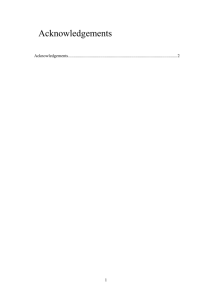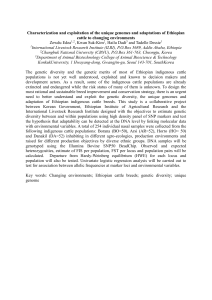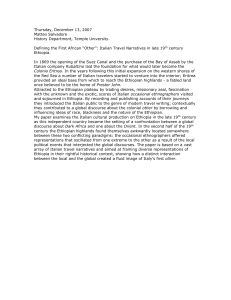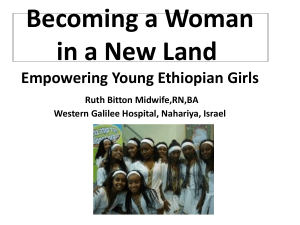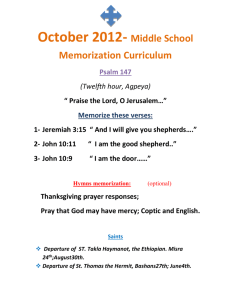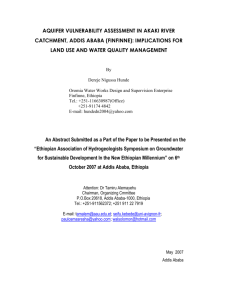Music in the Ethiopian American Diaspora
advertisement
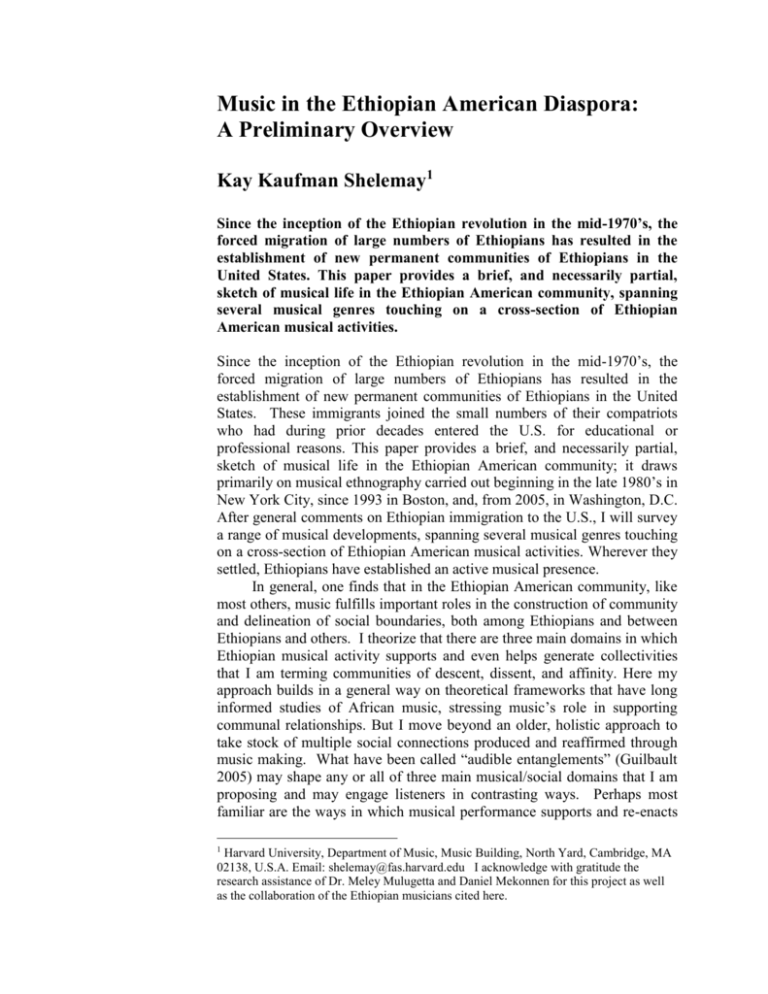
Music in the Ethiopian American Diaspora: A Preliminary Overview Kay Kaufman Shelemay1 Since the inception of the Ethiopian revolution in the mid-1970’s, the forced migration of large numbers of Ethiopians has resulted in the establishment of new permanent communities of Ethiopians in the United States. This paper provides a brief, and necessarily partial, sketch of musical life in the Ethiopian American community, spanning several musical genres touching on a cross-section of Ethiopian American musical activities. Since the inception of the Ethiopian revolution in the mid-1970’s, the forced migration of large numbers of Ethiopians has resulted in the establishment of new permanent communities of Ethiopians in the United States. These immigrants joined the small numbers of their compatriots who had during prior decades entered the U.S. for educational or professional reasons. This paper provides a brief, and necessarily partial, sketch of musical life in the Ethiopian American community; it draws primarily on musical ethnography carried out beginning in the late 1980’s in New York City, since 1993 in Boston, and, from 2005, in Washington, D.C. After general comments on Ethiopian immigration to the U.S., I will survey a range of musical developments, spanning several musical genres touching on a cross-section of Ethiopian American musical activities. Wherever they settled, Ethiopians have established an active musical presence. In general, one finds that in the Ethiopian American community, like most others, music fulfills important roles in the construction of community and delineation of social boundaries, both among Ethiopians and between Ethiopians and others. I theorize that there are three main domains in which Ethiopian musical activity supports and even helps generate collectivities that I am terming communities of descent, dissent, and affinity. Here my approach builds in a general way on theoretical frameworks that have long informed studies of African music, stressing music’s role in supporting communal relationships. But I move beyond an older, holistic approach to take stock of multiple social connections produced and reaffirmed through music making. What have been called “audible entanglements” (Guilbault 2005) may shape any or all of three main musical/social domains that I am proposing and may engage listeners in contrasting ways. Perhaps most familiar are the ways in which musical performance supports and re-enacts 1 Harvard University, Department of Music, Music Building, North Yard, Cambridge, MA 02138, U.S.A. Email: shelemay@fas.harvard.edu I acknowledge with gratitude the research assistance of Dr. Meley Mulugetta and Daniel Mekonnen for this project as well as the collaboration of the Ethiopian musicians cited here. Music in the Ethiopian American Diaspora Kay Kaufman Shelemay traditional patterns of descent, incorporating expressions of ethnic identity, national or regional patriotism, or religious affiliation during worship rituals. But beyond communities of descent so prominently expressed in the music of an immigrant community, musical performance also serves to mark and reify other social and political boundaries. For instance, music often galvanizes collective political action, giving rise to what I am terming communities of dissent. Finally, music often serves to bring outsiders into the Ethiopian musical and social orbit; indeed, there are many Ethiopian musicians in the United States who through their performances and recordings seek to reach a broader public both within and beyond their descent community, actively cultivating communities of affinity. I hope that it will become clear that any single musical recording or performance may, at different moments, catalyze and subsequently be associated with collectivities defined by descent, dissent, or affinity—and that at some moments, one musical style or performance can evoke two or even all three at once. In short, my intention here is both to provide an overview of Ethiopian music and musicians in their American diaspora, and to map musical performances directly on these social processes. In this way, I hope that we can better understand the roles that music plays in establishing and maintaining Ethiopian diaspora life. Within this broader theoretical framework, my discussion will touch on several aspects of the Ethiopian American community’s musical diversity. I will focus first on repertories associated with traditional Ethiopian ethnic musics. Next I’ll turn to music within Ethiopian Orthodox Church rituals in the U.S. Finally, I’ll give a very brief nod to the heterogeneous world of Ethiopian popular music. As we will see, Ethiopian traditional, secular musical styles that draw on songs and dances from various ethnic and regional groups in Ethiopia may, depending on the audience and context, generate communities of descent, dissent, or affinity. Music of Ethiopian Orthodox Church rituals, in contrast, remains more tightly bounded within their localities and rarely attract outside attention; the sacred Ethiopian Christian musical domain largely sustains communities of descent, although considerations of ethnicity, language, and church affiliation may engender, both implicitly and explicitly, aspects of dissent. The world of Ethiopian American popular music is an extraordinarily multi-faceted and lively one that seeks an audience. Popular music styles and the world of public performance place Ethiopian stars such as Aster Aweke, Gigi, Teddy Afro, and many others firmly in the business of generating affinity communities. But for reasons to be discussed below, issues of descent and dissent are invoked in different ways by virtually all these performers. Since the end of the revolution in 1991, music life in the Ethiopian American community has re-established ties to musical developments in Ethiopia, and a number of important Ethiopian musicians who long resided in the United States have in the last several years returned 2 Music in the Ethiopian American Diaspora Kay Kaufman Shelemay home.2 An added complexity in the popular music domain is its engagement with media and the ubiquity of concert tours across transnational networks. While this paper is too brief to give adequate attention to active transnational dynamics, in every aspect of Ethiopian music one must take homeland-diaspora interchange into careful consideration. The Arrival of Ethiopian Musicians in the United States: An Historical Note The exodus from Ethiopia since the mid-1970’s has served to establish a sizable North American community.3 According to the 2000 U.S. Census, Ethiopians are the second largest new African community, surpassed only by the number of Nigerian immigrants. However, the actual number of Ethiopians in the American diaspora is much more difficult to ascertain. The official figures do not always differentiate among Ethiopians, Eritreans, Oromo, and other refugees from the Horn of Africa; they surely understate the size of these communities both in individual locales and as a whole.4 The disparity between official numbers and unofficial estimates renders it extremely difficult to provide exact figures. 2 A move to repatriate has been particularly noticeable in the popular musical domain. Notable examples include Abegasu Kibrework Shiota, a keyboardist, producer, and arranger for musicians including Aster Aweke, Tilahun Gessesse, Mahmoud Ahmed, Theodros Tadesse, and others, who returned to Addis Ababa after residing in the United States from 1994-2003. In the traditional domain, following many years in Vermont and Washington, D.C., krar player Seleshe Demassae (aka Gash Abera Molla) returned to Addis Ababa to spearhead a project to restore and beautify Ethiopian urban environments. 3 A few Ethiopian musicians arrived earlier, for instance, Mulatu Astatke, who came to Boston during 1959-1960 to study at the forerunner of the Berklee School of Music, and subsequently, at the Harnett National School of Music in New York City. After his return to Ethiopia in the mid-1960s, Mulatu maintained his primary residence there while touring extensively as a performer; although he spent long periods out of the country and in recent years often visited his children, who lived in Washington, D.C. Mulatu’s life and career provides a singular example of a transnational Ethiopian musical experience that spans the entire period of the Ethiopian American diaspora. 4 For instance, a 1995 official summary of U.S. immigration figures recorded that approximately 46,000 individuals born in Ethiopia entered the United States between 19711994. (The Statistical Abstract of the United States, p. 11.) Yet five years earlier, a 1990 Ethiopian Community Development Council Report estimated a total figure (including Eritreans) as ranging between 50,000 and 75,000 people. (“The Development Needs of Ethiopian Refugees in the United States,” p. 20). The majority of documented Ethiopian immigrants to the United States since 1980 have come as refugees under provisions of the 1980 Refugee Act (Ibid., p. 21). However, a substantial number of undocumented Ethiopians have entered on short-term visas and remained in the United States. Likely the most reliable figures are those that emerge from local communities in relation to specific activities. For instance, The Ethiopian Community Mutual Assistance Association of Massachusetts operates a weekly radio program with an estimated listening audience at 5,000 (African Refugee NETWORK, p.10), providing some indication of the size of the Ethiopian community in that region in late 1990’s. See Solomon 2007: xvi for more details on challenges in estimating Ethiopian American population figures. 3 Music in the Ethiopian American Diaspora Kay Kaufman Shelemay Most Ethiopians have settled in major American cities, with the single largest concentration in the Washington, D.C. metropolitan area. There are also other sizeable communities in New York City, Atlanta, Dallas, Denver, Los Angeles, Seattle, Minneapolis, and Boston. While some highly-skilled Ethiopian immigrants have managed to enter careers in academia, medicine, and new technologies, many Ethiopian refugees work in service industries such as hotels, parking lots, and taxi services. In the United States, Ethiopian Americans have moved aggressively to establish their own community organizations and social networks which offer support for the substantial cultural adjustments that confront most individuals. Both public and private organizations help address issues of asylum as well as the pressing economic problems of those who are under or unemployed. The Ethiopian Yellow Pages published in the Washington, D.C. metropolitan area documents an Ethiopian community with its own accountants, attorneys, and dentists, a collectivity that maintains culinary and cultural traditions through its patronage of special groceries, restaurants, and music stores.5 As the site of the largest Ethiopian community in diaspora, it is not surprising that Ethiopian musical activity is most frequent and public in the Washington, D.C. metropolitan area. The density of musical activity there results in part from the convergence of a large number of musicians in the early years of diaspora formation. Musical activity was catalyzed early on in Washington, D.C. by the activity of record producer Amha Eshete, the innovative creator of the Amha Records label in Addis Ababa, and an early arrival to Washington in 1974, where he resided until 1997.6 Amha opened the first Ethiopian restaurant, the Blue Nile, in 1977, and later founded Kilimanjaro, a nightclub that served as a venue for Ethiopian artists, many of whom he was the first to bring to the United States in the early 1980’s. (Amha Ashete, Interview, 19 June, 2006) Traditional Ethiopian Musics in Diaspora The number of Ethiopian musicians in Washington, D.C. was swelled by defections following the 1987 “People to People Tour” sent from Ethiopia to the United States, when individuals such as Tesfaye Lemma, the director of Addis Ababa’s Orchestra Ethiopia, sought asylum in the United States. (Tesfaye Lemma, Interview, 7 April 2006; Getamesay Abebe, Interview, 18 July 2006.) Tesfaye soon brought together some of 5 The Ethiopian Yellow Pages (14th edition, 2007-2008) has a special section listing offices and businesses in Ethiopia, including hotels and restaurants. It carries numerous ads for travel agencies offering special fares to Addis Ababa and Asmara. Many musicians advertise their availability in this source. 6 In notes that accompany the first volume of the éthiopiques CD series, published in France by Buda Musique drawing heavily on recordings issued in the 1960’s and early 1970’s by Amha Records, editor Francis Falceto writes that Amha arrived in the U.S. in 1975 and returned to Addis Ababa in 1993. I recorded slightly different dates during an interview with Amha Ashete in Addis Ababa, 19 June 2006. 4 Music in the Ethiopian American Diaspora Kay Kaufman Shelemay Washington’s traditional secular musicians under the new appellation “The Nile Ethiopian Ensemble,” and further sought to anchor Ethiopian cultural life in the Washington D.C. metropolitan area by opening a Center for Ethiopian Arts and Culture (CEAC) in 1994. CEAC sponsored educational activities and served as a locus for preserving Ethiopian culture and music. It also housed a museum and an Ethiopian music and dance school. 7 CEAC served as the home base of the Nile Ethiopian Ensemble (NEE), which was the first Ethiopian folkloric troupe in the United States.8 The NEE performed in a variety of educational and institutional contexts as well as made appearances at events for Ethiopian communities throughout the United States. The NEE also performed publicly for broader American audiences through the early 1990’s in series sponsored by organizations such as World Music in New York City. The NEE ensemble usually included seven musicians who provided a continuous hour of spirited instrumental music, song, and dance, sung in various Ethiopian languages without translation or English-language commentary. The style and content of NEE performances were quite similar to those of the Addis Ababa folklore ensemble, Orchestra Ethiopia, which Tesfaye began directing in 1966 at the then Haile Selassie I University. By the mid-1990s, the NEE disbanded due to economic pressures and Tesfaye’s ill health. In 1999, several musicians formerly associated with the NEE began performing a folkloric program two nights a week at Dukem Restaurant, located on Washington, D.C.’s U Street at 12th ST. NW. The current, biweekly folklore show, which was developed by the owner of Dukem in collaboration with participating musicians, is reminiscent of those of both Orchestra Ethiopia and the NEE. Each performance presents a series of musical numbers drawn from repertories of different Ethiopian ethnic groups, accompanied by krar, mas∂nqo, and singer; each performance includes different regional costumes and choreographed dances. (Minale Dagnew, Interview, 25 January 2007). The musical shows at Dukem invoke multiple aspects of descent, incorporating both a nod to the diaspora’s ethnic diversity as well as acknowledging the Ethiopian state of which these ethnic communities were historically a part. Yet at the same time, the NEE seeks to attract a broader audience, especially tourists, and to build an affinity community for Ethiopian traditional arts. Both cultural (bah∂lawi) and modern (zämänawi) Ethiopian musical styles9 were marketed early on in various recording media through informal networks and at Ethiopian-owned shops. The Adams Morgan “Arts: Ethiopian Cornucopia.”, p. 29. Ensembles were established earlier among other Ethiopian communities abroad, notably in Israel by Beta Israel immigrants. The Meseret ensemble of Nazareth-Illit has been documented in a 1991 senior thesis by Nili Belkind,, University of California at Santa Cruz. 9 The homeland Ethiopian distinction between bah∂lawi (cultural) music and zämänawi (modern) music is often invoked by diaspora musicians; its use was reinforced in Washington, D.C., diaspora circles by Tesfaye Lemma. (Hana Shenkute, Interview, 25 January 2007.) 7 8 5 Music in the Ethiopian American Diaspora Kay Kaufman Shelemay neighborhood of Washington, D.C. was the first home for shops such as Ethio-Sounds, which claimed in its advertisements to be “the first Ethiopian Music Store in North America” and offered not just sound recordings and videotapes, but also jewelry, t-shirts, voltage converters, and other gifts. Ethiopian recording studios sprang up in the nearby Maryland and Virginia suburbs, where a great deal of Ethiopian institutional and residential life shifted in the 1990’s. Other more recent changes include the decline of the Adams Morgan area of the District of Columbia, which has since the early 2000’s slowly lost its status as the center of Ethiopian commerce and cultural life in the face of the exodus to the Washington suburbs. At the same time, the U Street area emerged as Washington, D.C.’s new Ethiopian American commercial center.10 One also finds networks of musicians traveling to different Ethiopian American communities to perform at community concerts or at special events such as weddings. However, some of the most regular and well-attended musical events among Ethiopian communities in every region of the U.S. take place within a traditional, but decidedly sacred realm, within local Ethiopian churches. In seeking an overview of Ethiopian ritual music11 in its diaspora, we must look to the liturgy of the Ethiopian Orthodox Churches as well as Ethiopian Evangelical churches. Liturgical Music in the Ethiopian American Churches Ethiopian Orthodox churches have been established throughout the United States. In most cities, several churches exist due to a variety of factors ranging from local residential patterns, to ethnic and political affiliations, to differing and contested relationships with the mother church in Ethiopia. In the 1970’s and the 1980’s, virtually all Ethiopian diaspora churches depended on the generosity of other Christian denominations for meeting space, most congregating on Sundays and major holidays in the facilities of a church of their local area following regularly scheduled services. By the mid 1990’s, churches in Washington, D.C., Seattle, and other cities attained a critical mass of congregants and began to buy or construct their own buildings. In the Boston metropolitan region, for example, four Ethiopian Orthodox churches have been established since 10 The migration of the Ethiopian commercial sector to U Street and suggestions that the neighborhood be renamed “Little Ethiopia,” following precedents in Los Angeles, has raised controversy between the Ethiopian and African American communities. The subject of the historical distance between new African immigrants to the U.S. and the longstanding African American community cannot be addressed here, but it grows out of historical, linguistic, and socio-economic factors. The U Street controversy stems also from the historical importance of U Street as America’s “Black Broadway,” documented in Westley (2005) and, discussed at considerable length, in Mohammed (2006: 60-72). 11 The changing relationships between diaspora Ethiopians and Eritreans often surface in the context of musical performances due to linguistic and musical markers of regional and ethnic identity. Divisions according to ethnic and national boundaries are frequently found in the organization of the expatriate churches. 6 Music in the Ethiopian American Diaspora Kay Kaufman Shelemay 1990; in 2000, Boston’s St. Michael’s Church purchased in the Boston suburb of Mattapan the small frame building it currently occupies.12 Beyond the economic pressures on the members committed to sustaining even a modest ritual cycle, the expatriate Ethiopian churches face the dilemma of a paucity of qualified clergy, especially outside Washington, D.C., which has a critical mass of ordained priests (qes) and musicians (däbtära). This situation has had implications for Ethiopian Orthodox churches in smaller communities, which struggles to maintain the esoteric Orthodox musical traditions and elaborate liturgical cycle. A given church is generally fortunate to obtain the services of even a single officiating priest who is then forced to perform the Q∂ddase (Mass) as well as all other aspects of the liturgy. When a priest is not available, some congregations worship with the guidance of liturgical recordings imported from Ethiopia. In communities with several churches, clergy sometimes work together, combining their congregations for major holidays and helping officiate as needed to cover for each other. (Qes Tsehai Birhanu, Interview, 8 April, 2007). Whenever possible and practical for the community, many churches import däbtära for annual holidays such as L∂dät and Fasika. Deacons are generally recruited from knowledgeable congregants and with one notable exception discussed below, there is little in the way of on-going education of clergy. A strong effort has been made to maintain the integrity of the Q∂ddase, which is the main focus of Orthodox Christian worship in most Ethiopian Orthodox Churches in North America consistent with American Orthodox and Catholic denominations. The Mahlet, the Cathedral Office with its more elaborate musical content, instruments, and dance, is performed only occasionally in most places, mainly on annual holidays. Even on these occasions, the musical content of the Mahlet is often quite attenuated, with an individual church fortunate enough to have retained services of one or two knowledgeable singers. Liturgical instrumental and dance traditions are maintained to the extent possible, with mäqqwamiya (prayer staff), s’äenas’∂l (sistrum), and käbäro (drum) brought out for annual holidays. In some instances, performance of the Mahlet is no longer an integral part of the ritual, but is presented “in concert” for the community on holidays, an event that can attract a sizable attendance.13 The regular Sunday Q∂ddase attracts a faithful congregation at most churches, with a majority of the women and a few men wearing traditional dress. Most Ethiopian Orthodox churches I have visited in Boston, Washington, and New York maintain separate sections for men and women, 12 The economics of church administration are challenging to Ethiopian American communities and all depend on their congregants for financial support. Women have played a major role “behind the scenes” in the establishment and financial organization of Ethiopian American churches, an important change in the formerly all-male administration of the Church in Ethiopia. (Mary Alemu Walker, Interview, 14 January, 2007.) 13 The Ethiopian Orthodox Church that has met since the mid-1980’s at Riverside Church on the Upper West Side of Manhattan has in the past videotaped such events and offered them for public sale. 7 Music in the Ethiopian American Diaspora Kay Kaufman Shelemay although these seating patterns are not always systematically observed. Many young children attend services, most roaming about the sanctuary and adjoining rooms. In general, the G∂‘∂z liturgy is maintained, with xeroxed excerpts of relevant texts distributed among congregants for their use. Homilies tend to be delivered in Amharic or Tigrinya, depending upon the ethnic and linguistic orientation of the congregation. There are few if any service books to be seen among congregants and the clergy appear to rely primarily on printed service books imported from Addis Ababa. Since the late 1990s, many churches have projected liturgical texts on screens to encourage congregational participation. Portions of the liturgy tend to be performed in antiphonal style and traditional modal usage (zema) is also generally observed, with a few liturgical portions sung in g∂‘∂z, araray, or ∂zl zema, selected by a märigeta (chief of the däbtära) or priest for performance and appropriate to a given day in the annual cycle. Q∂ne (improvised, sung liturgical poetry) is rarely performed, with the exception of the largest churches such as Debre Selam Kidist Mariam Ethiopian Orthodox Tewahedo Church in Washington, D.C., which has exceptional coterie of musicians, led by Liqä Mäzemran Moges Seyoum, an accomplished märigeta. Selam Kidist Mariam church is also exceptional in holding regular classes in Mahlet led by L.M. Moges. These classes, which have been held every Saturday morning for the last seven years, last for approximately one hour. During this time, L.M.. Moges leads liturgical portions for upcoming observances; participants sing along as well as record the class on cassette tapes for subsequent review and study. This insures that “when the time comes to sing them, we will hopefully come prepared and know them.” (Bililign Mandefro, Interview, 17 March, 2007) Amidst these strong attempts to preserve and transmit the traditional G∂‘∂z liturgy, one can also find striking signs of innovation. Perhaps the most marked departures from longtime Ethiopian Christian liturgical and musical conventions are the participation of women in performance of certain sections of the Mahlet, the sacred songs that include instrumental accompaniment and dance.14 In some churches, women are also called upon to do Gospel readings. Many Ethiopian Orthodox churches in the United States have further organized small choirs of young people to learn and sing hymns in Amharic. The repertory of “Sunday School songs,” draws primarily on hymns recently composed in Ethiopia, transmitted to North America by new arrivals or by sound recordings. The learned and talented qes and märigeta,Tsehai Birhanu of St. Michael’s Ethiopian Orthodox Tewahedo Church in Boston, composes hymns which are sung regularly by his congregation. 14 The participation of women had its genesis in urban Ethiopian Orthodox Sunday Schools during the revolution and the practice spread to the diaspora churches by the early 1990’s. 8 Music in the Ethiopian American Diaspora Kay Kaufman Shelemay The Ethiopian Orthodox Church in its American diaspora is also the site of other innovations. Some churches mount dramatic readings and other performances at points during and after the liturgy, enacting religious narratives appropriate to the occasion. A particularly notable musical occasion was a fundraising concert held at Kidus Gabriel Ethiopian Orthodox Tewahedo Cathedral in Washington D.C,. in 2006. The event featured performances of hymns by prominent Ethiopian singers and instrumentalists, all of whom dedicated their talents for the event. The benefit concert, which was filmed and is widely circulated on DVD (yäq∂eddus yared mätasäbiya [A Souvenir of Saint Yared])) ,throughout the United States, is said to have raised well in excess of $100,000 for the church. Many Ethiopian Americans, particularly younger immigrants, attend Ethiopian Evangelical churches. A number of factors appear at work here, including the loss of prestige of the Ethiopian Orthodox Church at home in Ethiopia. Like Ethiopian Orthodox churches, the Evangelical churches also tend to meet in facilities owned by other religious denominations. The Evangelical churches provide a marked contrast to the diaspora Ethiopian Orthodox churches. Their congregations consist mainly of young people who wear almost exclusively Western dress. The liturgy contains spoken prayers and homilies, often articulated over a soft instrumental background of guitar or synthesizer. Readings are punctuated by hymns, accompanied in harmony on the guitar and/or keyboard. Many churches project hymn texts in Amharic on a screen or church wall so that the congregation can participate more easily in the singing, Amplified recordings of hymns imported from Ethiopia are sometimes played at processional points in the ritual or if no song leader is present. These recordings are also available for sale after the service. In contrast to the Ethiopian Orthodox expatriate church, where people enter and exit freely, stop to greet each other, and where children make considerable noise, the congregations in the Ethiopian Evangelical services I have attended were quiet throughout in the service. At the end, new attendees introduce themselves to the congregation. Most congregants participate actively in hymnody, and lively hymns elicit verbal exclamations, clapping, and ululation. All of the Ethiopian churches I have visited, whatever their doctrinal stance, performed liturgies entirely in G∂‘∂z or Ethiopian vernacular languages, with virtually no English used. At all churches, too, the congregation members were almost exclusively Ethiopian, with only a few Rastafarians or other non-Ethiopians occasionally present. Despite differences in their liturgies and its musical content, all Ethiopian American churches appear to support considerable social activity. Most offer members refreshments and fellowship after rituals and appear to play a major role in the life of their local community. The church also provides a venue for performance of paraliturigical or secular musical traditions once part of community life. Following the ritual celebrating the 9 Music in the Ethiopian American Diaspora Kay Kaufman Shelemay New Year in one Boston Ethiopian Orthodox church, the day was further celebrated by young girls drumming and singing traditional songs. Thus the Ethiopian church in its American diaspora places musical expression at the center of its observance, using music to engage congregants in worship, to communicate through Ethiopian languages, and to support community well being and prosperity. Ethiopian Popular Music in Diaspora In the United States, the traditional musics of West and South Africa have long been paradigmatic of African music to a wider public. To date, the music of East Africa and the Horn have been little performed and are not widely known. The growing number of Ethiopian musicians in the United States and their increasing activity in releasing recordings and performing in concert thus provide new musical resource to a broader audience interested in world music. Following her arrival in Washington, D.C. in 1979, singer Aster Aweke, often called the African Aretha Franklin by Western journalists, had an active recording and concert career in the US. Aster tried to shape an affinity community with songs drawing on African American rhythm and blues as well as jazz- inflected styles. For example, a song in her second album in 1991, “Yedi Gosh,” drew on jazz and soul in both instrumental style and vocal techniques.15 Aster’s recordings were available by 1990 in the “world music” sections of major record shops, and she had an international following in Europe, reaching an Ethiopian audience and a broader public at the same time. Her repertory ranged from newly composed Ethiopian art song such as Y’Shebellu (“Name of an [Ethiopian] river)16, performed with piano accompaniment, to songs that fused Ethiopian melodies with a range of African American musical styles.17 At the same time, virtually all of Aster’s heterogeneous repertory speaks either explicitly or implicitly to her status as a member of the Ethiopian diaspora and her nostalgia for her native land. Many recordings have been produced by local studios and distributed in North America by Ethiopian singers seeking both Ethiopian listeners and a broader audience. Until the late 1990’s, the majority of American-produced Ethiopian recordings were issued on cassette, the most practical medium to reach members of the Ethiopian expatriate community struggling for economic viability. One such widely- circulated 1994 release by the singer Chachi18 was recorded in Los Angeles. Several songs on this cassette, such as the opening cut, “Africa,” were set to neo-Caribbean beats, signaling a desire to appeal to a wider audience. Supported by a standard 15 Aster Aweke, Kabu. New York: Columbia/Sony, 1991. Released on the compact disk Aster (Columbia, CK 46848, 1989), track 3. 17 For the influence of rhythm and blues, see “Teyim” (“Sepia”) on Aster, track 4. A song drawing on jazz and soul models in both instrumental style and vocal techniques can be heard in “Yedi Gosh” (“My Guy”), released on Kabu (Columbia, CK 47846, 1991), track 1. 18 Chachi, Global Rhythms, 1994. 16 10 Music in the Ethiopian American Diaspora Kay Kaufman Shelemay pop ensemble of guitar, keyboard, saxophone, and percussion, Chachi’s vocal style retained some traces of highland Ethiopian antecedents. However, traditional Ethiopian articulations such as ululation are mixed and alternated with African-American vocal forms such as rapping. The cassette jewel box contained notes entirely in English, along with an advertisement for the “Chachi Fan Club,” offering information on additional releases and tour dates. Yet while the cassette notes were in English, all songs on the cassette recording were in Amharic.19 Similar, Dawit “Messay” Mellesse’s Lottery20 also sought to appeal to a wider audience. A former performer with Addis Ababa ensembles such as the Roha Band, Ethio-Stars, and Walias, Dawit’s diaspora style is said in the recording’s notes to fuse “Ethiopian contemporary music with a variety of world beats to create an intoxicating sound.” The notes list rhythms as spanning boogie, ChaChaCha, Iskista [∂sk∂sta], Highlife, Hip Hop, and Soka. If a number of Ethiopian singers have sought to appeal to a wider public, very few have discarded a marked Ethiopian vocal style and virtually none have recorded songs with English texts. Within the last several years, coinciding with the return of prominent studio musicians from the American diaspora to their Ethiopian homeland, Ethiopian popular music seems to have retreated from ambitions of the 1990’s to garner an affinity community. Ephrem Tamiru provides a salient example; his early vocal solos accompanied by keyboard, bass, and saxophone, were first heard on three albums released in the United States. His song “Hagerei,”21 with a text recalling the natural beauty of the Ethiopian countryside and expressing feelings of nostalgia and loss, was widely circulated and sung among Ethiopian Americans. However, Ephrem’s most recent CD, Hualla Endaykocheshe, was produced and released in Addis Ababa in 2006, part of the wave of diaspora artists now recording at studios in their homeland. Even while the Ethiopian American recording industry has no doubt experienced the same economic pressures of the wider industry, a number of Ethiopian musicians in North America have organized their own bands which perform at local events and which travel to perform at concerts elsewhere. Concert occasions include fundraising parties for causes such as community sport teams. Late-night parties featuring visiting musicians are held on weekend evenings at a variety of hotels and clubs in major metropolitan areas throughout the United States. In contrast to the network of struggling immigrant musicians, whose recordings tend to be distributed informally among members of the Ethiopian community, marketed on websites, and sold in Ethiopian groceries and record shops, a few Ethiopian singers have begun to penetrate the popular music market among Ethiopians in the United States. A series Other recordings of songs in Ethiopian languages, such as Muhammed Tawio’s Changes (Vancouver, n.d.), are similarly mediated by English notes. 20 AIT Records, Minneapolis, Minnesota, 1995. 21 Included on the album Demo Jemeregne, 1996. 19 11 Music in the Ethiopian American Diaspora Kay Kaufman Shelemay of “Farewell Concerts” by Tilahun Gessesse during 2006-2007 attracted large crowds of Ethiopians and others in major American cities. Another notable, recent example is Teddy Afro (Tewodros Kassahun), whose concerts command large audiences across the United States. Teddy Afro’s music, in particular the title song “Yastaseryal,” from his 2005 CD of the same title, provides an excellent example of music of dissent. This song, and the singer’s concert performances, has galvanized a large community who contest the outcome of May, 2005 Ethiopian elections and the subsequent jailing of opposition leaders. The lyrics of “Yastaseryal” galvanized a dissent community that spread throughout the Ethiopian American diaspora and worldwide. Teddy Afro performs regularly in the United States, with recent concerts in Washington, D.C. (January, 2007), Boston (April, 2007), and elsewhere. In the increasingly transnational world of Ethiopian popular music many musicians have sought, but have not achieved, the formation of communities of affinity. They have succeeded in conveying messages of descent and dissent that change over the time. Perhaps the one Ethiopian musician to have successfully shaped a broader community of affinity in diaspora through his music is Mulatu Astatke. Mulatu’s instrumental Ethiojazz is not constrained by Amharic texts that limit the audience for songs of so many Ethiopian singers abroad. His music has brought a wide group of outsiders into the Ethiopian musical orbit, as demonstrated by its use in the soundtrack of Jim Jarmusch’s 2005 film, Broken Flowers. Mulatu’s 22 music, also heard in the éthiopiques series, makes the case that Ethiopian instrumental styles more easily construct affinity communities. Indeed, éthiopiques 20, Either/Orchestra & Guests (including Mulatu Astatke), released by Buda Records in 2006, contain recordings of Ethiopian tunes arranged and performed by an American band from Somerville, Massachusetts. While Mulatu’s Ethio-jazz compositions have reached a wider audience, it is also the case that his music has special resonance for Ethiopians of Orthodox Christian descent, especially the works such as “Dewel” and “Lent Time” that improvise on Ethiopian Orthodox Church modes and melodies. At other moments, Mulatu’s Ethio-jazz may speak to other Ethiopian communities of descent, who share his social (cosmopolitan, urban), regional (highland), and ethnic (Amhara) identity. Conclusion More ethnographic research is needed to document and interpret the multiple roles of music in the Ethiopian diaspora. Studies of individual musicians and their music will provide a fuller understanding of the complicated politics of Ethiopian, Eritrean, and Oromo communities abroad as they seek to redefine their own relationships both to their new locales and 22 See Ethio jazz and musique instrumentale 1969-1974. éthiopiques 4. Francis Falceto, Ed. Paris: Buda Records, c. 1997. 12 Music in the Ethiopian American Diaspora Kay Kaufman Shelemay to a changing Ethiopia. For the first generation of immigrants, song has emerged as a primary venue for sustaining Ethiopian language competence. At the same time, a reluctance to use English language texts has limited the reception of Ethiopian music to many outside the diaspora community. It is clear that Ethiopian diaspora music, almost whatever its genre—traditional or modern—has the capacity to catalyze communities of descent and dissent. Affinity communities that stretch beyond the boundaries of Ethiopian expatriates, however, are largely limited to instrumental styles, especially the big band and jazz sounds revived from the years immediately before the Ethiopian revolution. At the same time, traditional folkloric productions of traditional ethnic musics fit comfortably into a category of musical tourism and command some attention of an audience outside Ethiopian circles. In the musical arena, ever-changing technologies and the transnational flow of musicians and recordings provide insights into the economic status of the Ethiopian community abroad, as well as emerging communication networks and patterns of commodification. Through charting musical performance in all of its venues with attention to its role in social organization, one begins to construct a portrait of a community in transition, one that maintains close ties to its historical homeland and is simultaneously creating a new musical culture allied to North American tastes and global musical trends. References African Refugee NETWORK, Vol. 7, No. 1 [May 1997]: 10. “Arts: Ethiopian Cornucopia.” City Paper (14 June 1996), Washington, D.C., p. 29. Alpers, Edward A. and Khalid Koser. 2005. “Diaspora.” Encyclopedia Aethiopica, Vol. 2. Siegbert Uhlig, ed. Wiesbaden: Harrassowitz Verlag, pp.150-53. Belkind, Nili. 1991. “Ethiopian Jews in Israel—A Musical Ethnography.” Senior Thesis, University of California at Santa Cruz. Guilbault, Jocelyne. 2005. “Audible Entanglements: Nationa and Diasporas in Trinidad’s Calypso Music Scene.” Small Axe 1717, 9/1: 40-63. 13 Music in the Ethiopian American Diaspora Kay Kaufman Shelemay Mohammed, Mohammed Hamid. 2006. “Imagining and Performing Habasha Identity: The Ethiopian Diaspora in the Area of Washington, D.C. Ph.D. Dissertation, Northwestern University. Negus, Keith and Patria Román Velázquez. 2002. “Belonging and Detachment: Musical Experience and the Limits of Identity.” Poetics 30: 133-145. Tekle Mariam Woldemikael. 1996. “Ethiopians and Eritreans.” In Refugees in America in the 1990s: A Reference Handbook. David W. Haines, ed. Westport, CT: Greenwood Press, pp, 147-69. “The Development Needs of Ethiopian Refugees in the United States, Part I: Analysis.” September, 1990. Arlington, VA: Ethiopian Community Development Council, Inc., p. 20. The Ethiopian Yellow Pages. 2007-2008. 14th ed. Alexandria, VA: NT, Inc. The Statistical Abstract of the Unied States- 1995 (115th Edition). U. S. Department of Commerce, p. 11. Solomon Addis Getahun. 2007. The History of Ethiopian Immigrants and Refugees in America, 1900-2000. New York: LFB Scholarly Publishing LLC. Westley, Brian. “Nation’s Largest Ethiopian Community Carves Niche in D.C.” Associated Press, Washington, October 17, 2005. Yäq∂eddus Yared Mätasäbiya [A Souvenir of Saint Yared]. 2006. Washington, D.C.: Kidus Gabriel Ethiopian Orthodox Tewahado Cathedral. Ethnographic Interviews Cited Amha Ashete, Addis Ababa, 19 June 2006. Bililign Mandefro, Washington, D.C., 17 March 2007. Getamesay Abebe, Cambridge, MA, 18 July 2006. Hana Shenkute, Washington, D.C., 25 January 2007. Mary Alemu Walker, Cambridge, MA, 14 January 2007. Minale Dagnew, Washington, D.C., 25 January 2007. Tesfaye Lemma, Washington, D.C., 7 April 2006. Tsehai Birhanu, Marigeta, Boston, MA, 8 April, 2006. 14 Music in the Ethiopian American Diaspora Kay Kaufman Shelemay 15 Music in the Ethiopian American Diaspora Kay Kaufman Shelemay Front Page Note to Editor: I have used the Leslau system for transliteration of terms. However, I have given spellings of names and churches as they are used by the individuals and churches in the United States. Keywords: music musical ethnography Ethiopian American community diaspora Abstract: Since the inception of the Ethiopian revolution in the mid-1970’s, the forced migration of large numbers of Ethiopians has resulted in the establishment of new permanent communities of Ethiopians in the United States. This paper provides a brief, and necessarily partial, sketch of musical life in the Ethiopian American community, spanning several musical genres touching on a cross-section of Ethiopian American musical activities. 16
